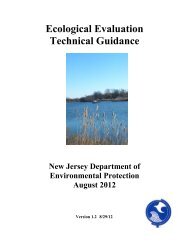Enhanced Attenuation – Fact Sheet - ITRC
Enhanced Attenuation – Fact Sheet - ITRC
Enhanced Attenuation – Fact Sheet - ITRC
Create successful ePaper yourself
Turn your PDF publications into a flip-book with our unique Google optimized e-Paper software.
<strong>Enhanced</strong> <strong>Attenuation</strong> <strong>–</strong> <strong>Fact</strong> <strong>Sheet</strong><br />
Interstate Technology and Regulatory Council<br />
<strong>Enhanced</strong> <strong>Attenuation</strong>: Chlorinated Organics (EACO) Team<br />
<strong>Enhanced</strong> <strong>Attenuation</strong> <strong>–</strong> A Solution to a Common Groundwater Remediation Problem<br />
• Many cleanup sites require a combination of remedies over time. A source removal<br />
action is often combined with active groundwater plume treatment, such as pump-andtreat,<br />
and ultimately monitored natural attenuation (MNA). A major challenge in this<br />
sequence is determining how and when to transition from more active treatments to MNA<br />
or, conversely, when to intervene at a site in MNA. Sites can get “stuck” in the process,<br />
delaying achievement of long-term groundwater cleanup goals.<br />
• <strong>Enhanced</strong> <strong>Attenuation</strong> (EA) is a plume remediation strategy to achieve groundwater<br />
restoration goals by providing a “bridge” between source zone treatment and MNA<br />
and/or between MNA and slightly more aggressive methods. EA provides an organized,<br />
scientific, and disciplined approach to implement treatment technologies at appropriate<br />
sites and at appropriate times. Various remediation technologies can be designed to<br />
reduce the source flux and/or increase the attenuation capacity/rate in the plume to assure<br />
the plume will stabilize and shrink.<br />
• While MNA is based on natural attenuation processes with “no human intervention,” EA<br />
adds human intervention to boost existing attenuation processes. This intervention<br />
enables less energy-intensive attenuation processes to achieve cleanup goals where<br />
natural attenuation processes are insufficient to reach those goals in the required<br />
timeframe.<br />
• Specifically, the EA strategy combines:<br />
‣ Detailed knowledge, investigation, and monitoring of a site’s natural processes<br />
and plume behavior. As with MNA, EA requires a design basis, documentation,<br />
monitoring, and contingency plans in case the system does not perform as expected.<br />
The EA approach is consistent with MNA, but in addition, provides a supplementary<br />
toolbox to support evaluation of remediation metrics and overall progress.<br />
Compared to MNA, EA requires expanded use of deterministic models to project<br />
future plume behavior, plume response to potential enhancements, and the response<br />
of natural attenuation processes.<br />
‣ Remediation technologies with enhancements. Most existing remediation<br />
technologies can be used to support the EA strategy. These technologies range from<br />
methods that reduce contaminant releases from the source area to methods that<br />
increase the attenuation rate of contaminants in the entire system. The important<br />
feature is that they are designed and implemented according to mass balance<br />
principles.<br />
<strong>ITRC</strong> EACO Team-11/28/05
Benefits of <strong>Enhanced</strong> <strong>Attenuation</strong><br />
The consensus view of the <strong>ITRC</strong> EACO Team is that EA may encourage systematic<br />
environmental solutions that are creative, effective, and efficient.<br />
• <strong>Enhanced</strong> <strong>Attenuation</strong> facilitates transition of contaminated sites through the<br />
remediation process. Many sites require a combination of remedies over time (i.e.,<br />
treatment-train approach). Implementing EA using the concepts of plume stability and<br />
mass balance facilitates the transition of the site to MNA, especially for sites with<br />
ongoing active treatment and for sites where plumes are currently nearing stability.<br />
(Figure 1).<br />
• <strong>Enhanced</strong> <strong>Attenuation</strong> complements MNA and expands remediation opportunities.<br />
Using a tailored intervention approach, successful EA strategy enables sites to realize<br />
some of the benefits of MNA. The type of intervention technology will be dependant on<br />
site-specific information.<br />
• <strong>Enhanced</strong> <strong>Attenuation</strong> encourages energy efficiency and developing the best<br />
solutions for the environment. Deploying EA technologies results in naturally<br />
sustainable treatments that require less energy and investment to reach environmental<br />
cleanup goals. As a result, sustainable treatments are often less intensive, less expensive,<br />
and less disruptive to property and the environment, and can potentially reduce the time<br />
required to cleanup the site. These naturally sustainable treatments can be implemented<br />
to reduce residual contamination in source treatment areas as well as contaminants in the<br />
associated subsurface groundwater plume.<br />
Source<br />
Rem oval<br />
and/or<br />
Treatm ent<br />
Interdiction<br />
and Active<br />
Remediation<br />
?<br />
<strong>Enhanced</strong><br />
<strong>Attenuation</strong><br />
Monitored<br />
Natural<br />
<strong>Attenuation</strong><br />
excavation<br />
in situ chemical destruction<br />
thermally enhanced removal<br />
Pump and treat<br />
recirculation wells<br />
in situ bioremediation<br />
permeable reactive barrier<br />
phytoremediation<br />
permeable biotreatment<br />
system<br />
Figure 1.<br />
Transition to sustainable technologies using naturally available processes.<br />
For more information on the EA concept and technologies, please contact:<br />
<strong>ITRC</strong> Web Site: http://www.itrcweb.org/homepage.asp<br />
Judie Kean (<strong>ITRC</strong> EACO Team Co-Leader)<br />
Florida Department of Environmental Protection<br />
(850) 245-8927; judie.kean@dep.state.fl.us<br />
Kimberly Wilson (<strong>ITRC</strong> EACO Team Co-Leader)<br />
South Carolina Department of Health and Environmental Control<br />
(803) 896-4087; wilsonka@dhec.sc.gov<br />
<strong>ITRC</strong> EACO Team-11/28/05
















